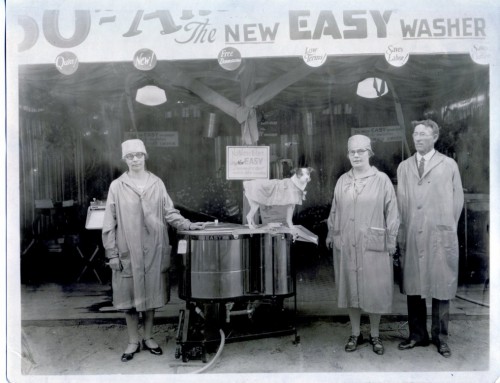by TeAnna, Exhibits Intern
Clothing is a miraculous thing. For centuries, people from all from all regions, all socioeconomic statuses, utilized clothing and fashion as a way to tell their story. Whether it was simple, practical outfits for the working class, or fashionable, ritzy clothing belonging to the upper class, we can better understand the social history of the people who wore these clothes.
Fortunately, the WHC archives have many articles of clothing that were generously donated. Some have connections back to significant figures in Oregon history, while some articles were worn by the average person, such as you and me. In their own sense, these collections tell the story of their original owners/ wearers, however, altogether, these collections tell a great story: a story of how clothing styles have progressed through Western America. The progression of style, however, does not come from anywhere, but rather historical and social events. Take for example the Great Depression. Clothing for the average individual became modest and simple, rather than detailed and showy like one decade earlier during the “Roaring ‘20’s” (1920’s). As money to buy new clothes dwindled away, people turned to making their own from flour sacks and other cheap material. We must remember, that be that as it may, those with money during the Great Depression wore more than just flour sack clothing because they could afford to do so, separating them from this group of people.
This upcoming winter, there will be a new featured exhibit here at the Willamette Heritage Center at the Mill, unofficially titled “Clothing Through Time”. The purpose of this exhibit is to highlight stories of individuals that generic history narratives might have been overlooked. Over the next couple months, I will be weekly blogging about my thoughts and ideas as this exhibit slowly comes together. Weekly, you will find clothing I find to be interesting and/or fascinating, or maybe clothing that I know nothing about with the hopes that you, the readers, would. It is fascinating to look at how even just the fit of a dress slowly changes and progresses throughout history, alongside the changes in society’s definition of modesty. As the definition of “modesty” slowly becomes less and less conservative, so do the lengths of women’s dresses; sleeves begin to move above the elbow and necklines slowly begin to drop. And even though the rich wore different clothes than the poor, this theme of shifting modesty was visible in all clothing of all economic status. A magical thing about clothing: regardless of the status of who wore it or even what it looked like, clothing did and still does connect us all together.




Check your first line. WWII changed fashions also as we were told they needed to conserve material for the war effort. Lapels were made narrower on men’s suits for an example.
Looking forward to seeing some of the individual items that will be featured in the exhibition! I was recently amazed to see the items of clothing that have been preserved in the Irish bogs from Medieval times. On view in the National Archaeological Museum in Dublin.